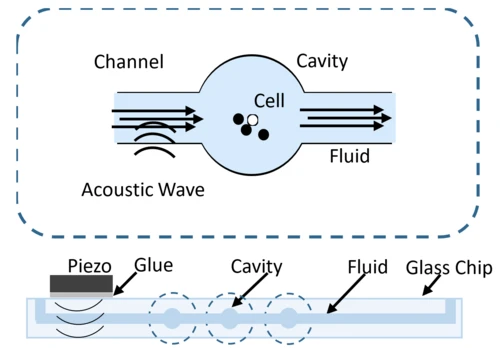Advanced Cell Manipulation in Microfluidic Systems
The precise manipulation of cells within microfluidic environments is fundamental to a broad spectrum of scientific and biomedical endeavours. Techniques such as optical tweezing, magnetic sorting, dielectrophoresis, and acoustofluidics each offer distinct advantages for the capture, separation, and concentration of cells and particles [1, 2].
Among these, acoustofluidic chip arrays represent a particularly promising platform for the non-invasive, label-free manipulation of single cells and cellular aggregates. This approach enables highly parallelised, controllable experimentation, providing a powerful means to investigate cellular responses to pharmacological agents under physiologically relevant conditions.
In collaboration with the Heinz Nixdorf Chair of Biomedical Electronics, based at TranslaTUM on the campus of the Technical University of Munich’s University Hospital Klinikum rechts der Isar, we are engaged in the co-development of next-generation acoustofluidic chip architectures. Our joint efforts encompass both experimental validation and advanced simulation studies aimed at enhancing device performance and functionality.
Our professorship contributes deep expertise in the design and modelling of micromechanical systems, with a particular emphasis on the simulation of coupled physical phenomena in micro- and nanoscale devices. This interdisciplinary collaboration seeks to advance the frontiers of biomedical microfluidics and to lay the groundwork for novel diagnostic and therapeutic technologies.
References
[1] M. Costa et al., "EchoGrid: High-Throughput Acoustic Trapping for Enrichment of Environmental Microplastics," Analytical chemistry, early access. doi: 10.1021/acs.analchem.4c00933.
[2] C. Wang et al., "Acoustic 3D trapping of microparticles in flowing liquid using circular cavity," Sensors and Actuators A: Physical, vol. 363, p. 114698, 2023, doi: 10.1016/j.sna.2023.114698.
